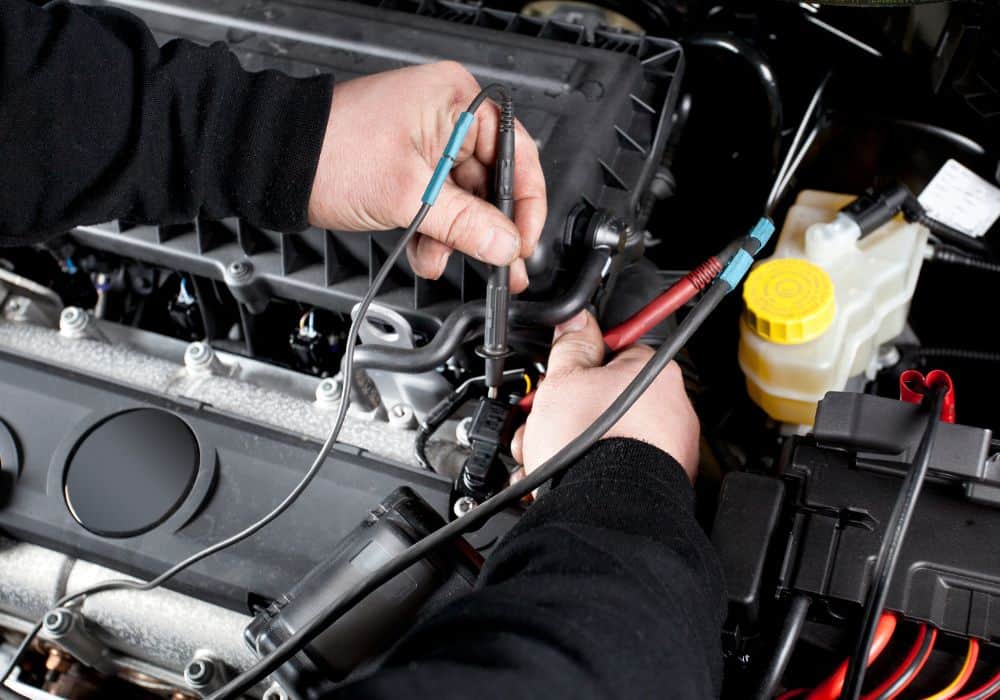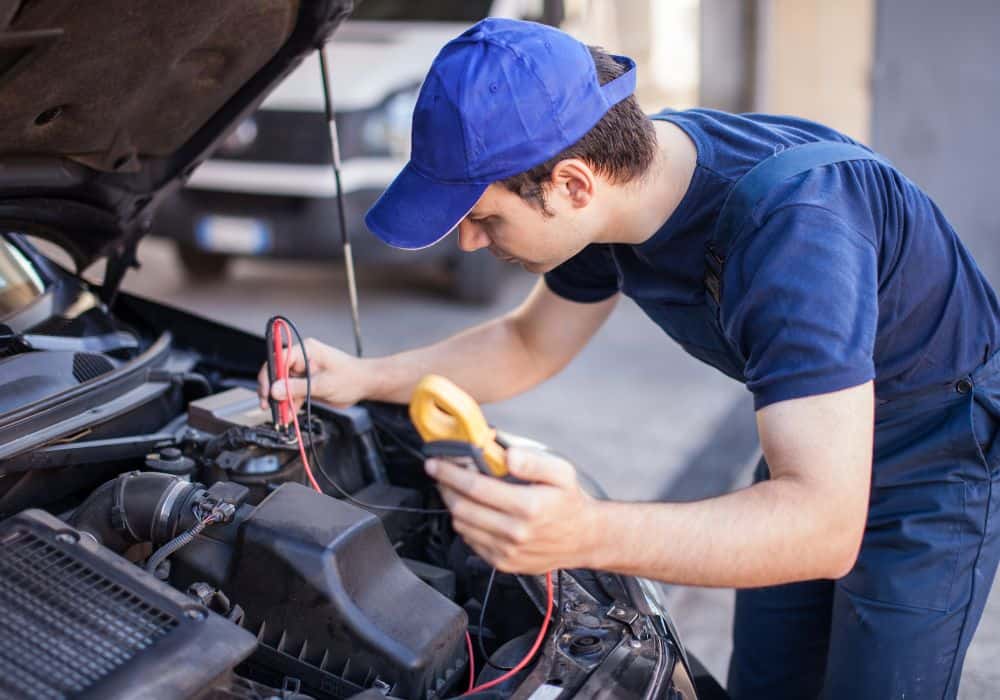When your car won’t start, the first thing you should do is check the battery. However, if the battery is good, then it’s time to start looking at other possible causes. This is because if your car isn’t starting, the battery might not be the problem.
In fact, there are several other components that could be causing your car not to start. In this blog post, we will discuss some of the most common reasons why a car won’t start (that isn’t your dead battery!) and what you can do to fix the issue.
Let’s check it out.
Table of Contents
How Do I Know It’s Not My Car Battery?
Before we get into looking at the other components that could be causing your car not to start, let’s make sure it’s not the car battery. To make sure, you can use a multimeter to check the battery’s voltage. If the voltage is between 12 and 14 volts, then it’s likely that your battery is in good condition.
If the voltage is off, you can give your battery a jump-start to get it going again. However, if the battery appears to be fine, then it’s time to move on and look at some of the other components that could be causing your car not to start.
Troubleshooting Why Your Car Won’t Start (When it’s not the Battery)
It can be so frustrating when your car won’t start and you’re not sure why. Here are some of the most common reasons why a car won’t start:
1. Check the Starter Motor
The starter motor is one of the most common reasons why a car won’t start but the battery is good. If your starter motor has failed or become worn over time, it will no longer be capable of powering your engine.
The starter motor is responsible for turning the engine over when you turn the key in the ignition. If the starter motor is making a clicking sound, then it may be time to check it and possibly replace it.
2. Check the Cables and Wires
Sometimes, the issue can be as simple as a loose connection somewhere in the car’s electrical system. Check your battery cables and other wires for any signs of anything loose that might be upsetting the electrical connection.
Also, if the cables and wires are corroded, they may not be able to deliver enough power to start the car. You should check the battery terminals, starter motor wires, and other cables for corrosion. If you find any corrosion, you should clean it off with a wire brush.
Replace any damaged parts and make sure they are securely connected to whatever car parts are necessary.
3. Check the Fuel System
If your engine is not receiving enough fuel, then it won’t start. Therefore, you should check your fuel tank, fuel lines, fuel pump, and filters to make sure they are all intact and functioning properly.
If there is a clogged fuel filter or there are any blockages or clogs in the fuel lines, this could cause the car not to start. You should have these parts checked and cleaned out or replaced as needed.
4. Check Your Ignition System

The ignition system includes several parts, including the spark plugs, distributor cap, ignition coils, and neutral safety switch. Any of these parts can prevent your car from starting when they fail or malfunction, possibly even causing engine misfire issues.
To check the ignition system, use a multimeter to test each component for its voltage. If the ignition switch or any of the components have a low voltage output than what is expected from it then you should get that part checked at an auto repair shop.
5. Check For Other Issues
There could be several other issues preventing your car from starting aside from what has been discussed above. For example, it could be your alternator, your transmission, or corrosion on the battery terminals, among other things. It could even be something as simple as having an empty gas tank.
In most situations, you should have an experienced auto technician take a look at your vehicle, especially if it’s an issue you are not comfortable fixing by yourself.
How to Maintain Your Car So It Runs A Long Time
Now that we know how to troubleshoot your vehicle not starting, let’s look at how to take care of it from day one. If you want your car to run for a long time, then you need to perform regular maintenance. Here are some tips on how to care for your car:
1. Check Levels of Liquids
Make sure you check the levels of all the liquids in your car regularly. This includes oil, coolant, transmission fluid, power steering fluid, and brake fluid. Check for any leaks or low levels that need to be topped off or replaced.
2. Test Battery Voltage
Use a voltmeter to test the battery’s voltage from time to time to make sure it is still functioning correctly. This is one way to perform what is called a load test.
A load test is a great way to make sure you have a good battery that has enough power to start the car. It tests how much current the battery can produce under load, and also checks for any issues with its voltage. If the voltage is too low then this could indicate that it needs to be replaced soon.
3. Replace Spark Plugs Regularly
Bad spark plugs are one of the most important components in your vehicle and should be replaced every few years or as recommended by your manufacturer.
4. Have Your Engine Tuned Up Regularly
Having your engine tuned up regularly is essential for your car to run smoothly and efficiently. Have a qualified mechanic check your ignition coils, distributor cap, fuel pump, and any other vital car parts that might need replacing or tuning up.
5. Check Fuel System Parts Regularly
Make sure you check the fuel tank for leaks as well as the fuel lines and filter for any obstructions that could prevent the vehicle from starting altogether. If you drive a diesel, then be sure to keep it inside the garage during the cold winter months to avoid your fuel gelling.
6. Inspect Electrical Components

It’s important to inspect all of your electrical components regularly, such as headlights, dashboard lights, key fob buttons, and starter motor wires. Make sure they are working correctly and replace them when necessary.
7. Replace Your Timing Belt
Your timing belt should be replaced every so often as recommended by your manufacturer. If it’s not replaced on time, this could cause serious damage to other parts of the engine like the camshaft, crankshaft, and distributor.
8. Check the Tire Pressure
Tire pressure is one of the most overlooked components when it comes to maintaining your vehicle. If the tire pressure is low, it could cause issues with your driving.
You should check the pressure of all four tires with a tire gauge on a monthly basis and make sure that it is up to recommended levels. If the tire pressure is low, inflate the tires to the correct pressure.
FAQs
Now that we have discussed car maintenance, let’s answer some common questions about car batteries.
Q1: What is the most common reason for a dead car battery?
The most common reason for a dead car battery is leaving a light on or draining the battery by having accessories plugged in while the engine is off. It can also happen due to it having been several years since you last replaced it.
Q2: What is the most common cause of a car not starting?
The most common cause of a car not starting is usually due to a dead battery. However, it could also be a faulty starter motor, bad ignition switch, bad spark plugs, battery cables that are corroded or loose, a clogged fuel filter, or a number of other things. If none of these seem to be the problem then you should take your vehicle into an auto repair shop and have a trained professional look at your vehicle.
Conclusion
There you have it! By following these troubleshooting tips and taking care of your vehicle regularly, you can help ensure that it runs properly for a long time and reduce any unexpected breakdowns or problems with starting your car. Because, really, that is the very last thing you need – especially on cold mornings or when you are already late for work!
To reiterate, make sure to check the battery’s voltage regularly and replace any components that need to be replaced, such as spark plugs, fuel filters, air filters, timing belts, and more. And if all else fails then you should take your car to a repair shop for further diagnosis. The better you take care of your vehicle upfront, the fewer issues you will have down the road.
What other issues have you come across that keep your car from starting? Let us know in the comments below!
